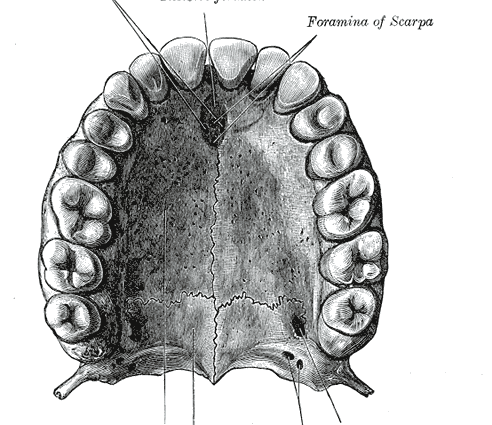Contents
Incisive
The incisor (derived from the term incision, from the Latin incisio, to incise) is a type of tooth, located in the oral cavity and used to cut food.
Incisive anatomy
Structure. The incisors are flattened teeth with a thin, sharp edge. Each incisor constitutes an innervated organ, irrigated and composed of three distinct parts (1):
- The crown is the visible part of the tooth. It is made up of enamel, dentin and the pulp chamber. This part has a flattened shape in the case of the incisor.
- The neck is the point of union between the crown and the root.
- The root is the invisible part anchored in the alveolar bone and covered by the gum, which is made up of cementum, dentin and pulp canal. This part is unique in the case of the incisor.
Number and position. The human dentition has eight incisors distributed as follows (2):
- Two upper medial incisors
- Two upper lateral incisors
- Two lower medial incisors
- Two lower lateral incisors
They constitute the dental arches located in front of the maxilla and the mandible, corresponding respectively to the upper and lower jaws.
Incisor physiology
Composition of the dentition. In humans, three dentitions follow one another. The incisors appear twice, during the first and second dentition. During the first dentition, the eight incisors appear in children between 6 and 8 months, and constitute part of the temporary teeth or milk teeth. (2) Between 6 and 8 years, the temporary teeth fall out and give way to permanent teeth, of the same number, which correspond to the second dentition. (3)
Role in food. (4) Each type of tooth has a specific role in chewing depending on its shape and position. The incisors have the role of cutting food.
Aesthetic role. The incisors are the first visible teeth and have an important role in dental aesthetics.
Incisor pathologies
Bacterial infections.
- Tooth decay. It refers to a bacterial infection that damages the enamel and can affect the dentin and pulp. Symptoms are dental pain as well as tooth decay. (5)
- Tooth abscess. It corresponds to an accumulation of stinks due to a bacterial infection and is manifested by sharp pain.
Periodontal diseases.
- Gingivitis. It corresponds to inflammation of the gum tissue caused by bacterial dental plaque. (5)
- Periodontitis. Periodontitis, also called periodontitis, is inflammation of the periodontium, which is the supporting tissue of the tooth. Symptoms are mainly characterized by gingivitis accompanied by loosening of the teeth.5
Dental trauma. The structure of the tooth can be altered following a shock. (6)
Dental abnormalities. Various dental anomalies can be observed. They can be linked to the size of the teeth, their number, their position or even their structure.
Incisor treatments
Oral treatment. Daily oral hygiene is necessary to limit the onset of dental disease. Descaling can also be carried out for prevention.
Medical treatment. Depending on the pathology diagnosed, drugs may be prescribed such as painkillers or antibiotics.
Dental surgery. Depending on the pathology diagnosed and the development of the disease, surgical treatment may be carried out with, for example, the fitting of a dental prosthesis.
Orthodontic treatment. This treatment consists of correcting malformations or bad dental positions.
Examinations of the incisors
Dental examination. Carried out by the dentist, this examination makes it possible to identify anomalies, diseases or trauma in the teeth.
X-ray. If a pathology is found, an additional examination is carried out by radiography of the dentition.
History and symbolism of the incisors
The expression “the teeth of happiness” is used to designate the distance between the two upper medial incisors. In dentistry, a gap between two neighboring teeth is called a diastema (7).










